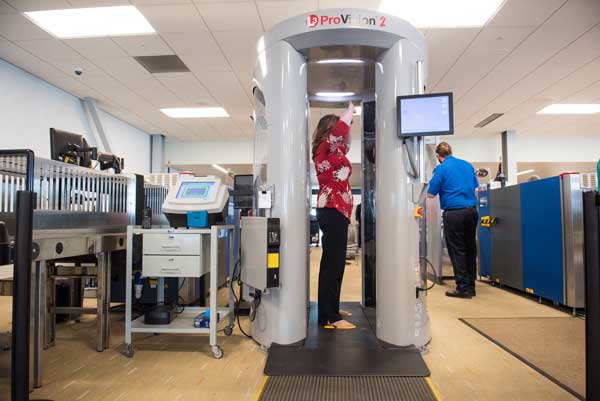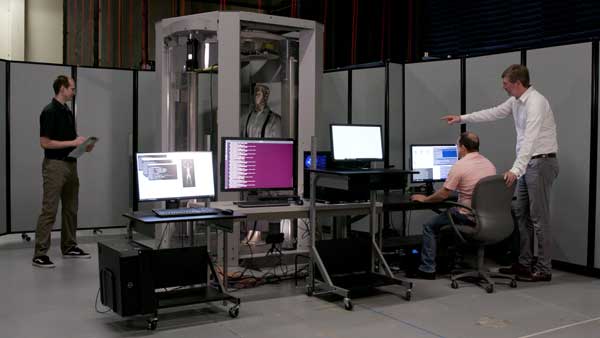Faster algorithm development may keep shoes on

Air travelers may see faster, safer security checkpoints — no need to open bags or remove liquids or shoes — thanks to the award-winning work of Sandia and their partners who have developed an open architecture for airport screening systems.
The Open Threat Assessment Platform, developed with Pacific Northwest National Laboratory, NASA and industry partners for the Department of Homeland Security’s Science and Technology Directorate and the Transportation Security Administration, will allow officials to respond more quickly and easily to rapidly changing threats to air travel safety.
The TSA’s current screening systems, such as X-ray machines and body scanners, are proprietary systems that scan, annotate and report in different ways, without communicating with each other. “Only existing vendors can develop ways to address new threats, which have limited the TSA’s flexibility to innovate,” said project lead Andrew Cox, a Sandia research and development systems analyst previously at the TSA.
“When we wanted to change how we screen in response to new threats, the technology was too rigid. The TSA compensated by adding procedures. There’s a shoe bomber and you have to take your shoes off; liquid explosives arrived, and the TSA had to limit liquids and gels,” Andrew said.
Sandia partnered with Pacific Northwest National Laboratory, which developed a new high-definition body scanner, and industry partners like Stratovan to create the Open Platform Software Library, which will allow the TSA to work with any vendor for a needed algorithm.
Austin Silva, a Sandia cognitive scientist who oversees development of the library, said the open architecture will provide a common set of interfaces to develop against.
A wider variety of vendors will more quickly and reliably be able to create security upgrades with new algorithms that integrate into existing screening — seamlessly for travelers. “Like LEGOs, you’ll be able to rapidly introduce new pieces,” Austin said. The system may also be able to use different algorithms at different times based on threat level.
Better data collection means safer, more seamless travel

Faster innovation in detection will make air travel safer, said Ed Jimenez, an optical engineer at Sandia. The TSA will be able to collect data continuously and improve algorithms every few months. Standardizing and modularizing design with an open architecture should benefit industry. Once the TSA approves them for access, companies will be able to collaborate.
Improved scanners will also improve passenger experience. “When you put an object in your bag that’s mistakenly flagged as a threat, the enhanced algorithm has the potential to not ring as a false positive alarm,” Ed said. “You won’t have to open the bag and slow down the line.”
Now in its seventh year, the Open Threat Assessment Platform project has involved almost a dozen industry partners, including algorithm developers, X-ray vendors and software specialists. It’s part of a worldwide push to open software architecture. Once deployed in the field, the platform will “change the safety profile of airports rapidly,” Austin said. “We’ll be able to say, we’ve seen this emerging threat; can anyone in the community develop this algorithm? From there, we’ll be able to manage updates across the aviation security infrastructure.”
While the Open Threat Assessment Platform is likely to save the TSA money and provide revenue to industry, Sandia’s involvement benefits the project because, Andrew said, “if you’re going to develop a standard for one open architecture, you want it to be market-neutral. We’re not going to be playing favorites with any vendor. Everything we or our subcontractors develop would be government owned. We were one of few with the technical expertise to oversee it, and we could implement contracts and partnerships to test out these ideas quickly and effectively.”
The Open Platform Software Library’s main code was primarily developed by Stratovan; Sandia continues to contribute cybersecurity expertise for analysis. “We can be the neutral party to evaluate code, then share our results in ways that are actively changing some of their design principles,” Austin said. “We have been able to build cybersecurity into the design process.”
Sandia also built a prototype TSA checkpoint at Kirtland Air Force Base to rapidly gather data on detection of live explosives in bags. “These systems are locked down in an airport,” Ed said, “but we were able to procure an X-ray machine, stand up a checkpoint at an explosive range and collect data from real explosives scanned in suitcases. It increased our data acquisition; something that would take a full day took only hours.”
Award-winning work to make real-world impact
In October, Andrew, Austin and Ed received an Interagency Partnership Award, Mid-Atlantic Region, from the Federal Laboratory Consortium for their work with Pacific Northwest National Laboratory, NASA, TSA and the Department of Homeland Security’s Science & Technology Directorate (Screening at Speed Program and Transportation Security Laboratory), for their work to develop and transition high-definition advanced imaging technology with Pacific Northwest National Laboratory’s new shoe scanner, which will allow travelers to keep their shoes on. The Federal Laboratory Consortium National Awards recognize federal labs and their partners for outstanding technology transfer achievements.

The Open Platform Software Library has been approved for international distribution; partners in the United Kingdom are already using it, Andrew said. The project aligns with DOE’s Office of Science priorities on artificial intelligence and machine learning and the Department of Homeland Security’s focus on proactive responses to identify, detect and prevent attacks. The team is using real automated threat recognition software to look at proving sensors — CT and advanced imaging technology systems — by testing with real bags, toiletries, laptops and simulated explosives to demonstrate system accuracy. They hope to be in select airports by late 2022.
The project has been personally rewarding for Sandians. “In the research world, sometimes you wait decades for your work to make a difference,” Ed said. “This is already impacting the way next-generation systems should be designed.”
“It’s very exciting,” Austin added. “Most of my work is very research focused. This is fully proving out a concept to have a technology that affects millions of people traveling every day. Other airports and agencies across the world are saying this could be a game-changer. When we’re walking through the airport, we’ll be able to directly see how our work has changed aviation security.